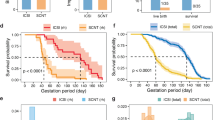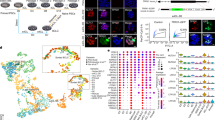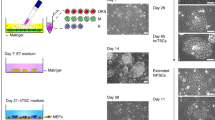Abstract
Therapeutic cloning, whereby somatic cell nuclear transfer (SCNT) is used to generate patient-specific embryonic stem cells (ESCs) from blastocysts cloned by nuclear transfer (ntESCs), holds great promise for the treatment of many human diseases. ntESCs have been derived in mice and cattle, but thus far there are no credible reports of human ntESCs. Here we review the recent literature on nuclear reprogramming by SCNT, including studies of gene expression, DNA methylation, chromatin remodeling, genomic imprinting and X chromosome inactivation. Reprogramming of genes expressed in the inner cell mass, from which ntESCs are derived, seems to be highly efficient. Defects in the extraembryonic lineage are probably the major cause of the low success rate of reproductive cloning but are not expected to affect the derivation of ntESCs. We remain optimistic that human therapeutic cloning is achievable and that the derivation of patient-specific ntESC lines will have great potential for regenerative medicine.
This is a preview of subscription content, access via your institution
Access options
Subscribe to this journal
Receive 12 print issues and online access
$209.00 per year
only $17.42 per issue
Buy this article
- Purchase on SpringerLink
- Instant access to full article PDF
Prices may be subject to local taxes which are calculated during checkout




Similar content being viewed by others
Change history
26 September 2007
In the version of this article initially published, the legend for Figure 1 is inaccurate. The original legend for Figure 1c failed to note that the cells derived from cattle embryos were embryonic stem cell (ESC)-like trophectoderm cell colonies. The full legend for Figure 1c should read “Therapeutic cloning: percentage ESC line derivation (mice) or ESC-like trophectoderm cell colony formation (cattle) from embryos derived from both IVF and nuclear transfer." This error has been corrected in the HTML and PDF versions of the article.
References
Hochedlinger, K. & Jaenisch, R. Nuclear transplantation, embryonic stem cells, and the potential for cell therapy. N. Engl. J. Med. 349, 275–286 (2003).
Wakayama, T. et al. Differentiation of embryonic stem cell lines generated from adult somatic cells by nuclear transfer. Science 292, 740–743 (2001).
Wang, L. et al. Generation and characterization of pluripotent stem cells from cloned bovine embryos. Biol. Reprod. 73, 149–155 (2005).
Kennedy, D. Editorial retraction. Science 311, 335 (2006).
Cibelli, J.B., Lanza, R.P., Campbell, K.H. & West, M.D. Principles of Cloning (Academic Press, San Diego, 2002).
Kruip, T.A. & den Daas, J.H.G. In vitro produced and cloned embryos: effects on pregnancy, parturition and offspring. Theriogenology 49, 43–52 (1997).
Zhu, J. et al. Improvement of an electrical activation protocol for porcine oocytes. Biol. Reprod. 66, 635–641 (2002).
Cibelli, J.B., Campbell, K.H., Seidel, G.E., West, M.D. & Lanza, R.P. The health profile of cloned animals. Nat. Biotechnol. 20, 13–14 (2002).
Young, L.E., Sinclair, K.D. & Wilmut, I. Large offspring syndrome in cattle and sheep. Rev. Reprod. 3, 155–163 (1998).
Farin, P.W., Piedrahita, J.A. & Farin, C.E. Errors in development of fetuses and placentas from in vitro-produced bovine embryos. Theriogenology 65, 178–191 (2006).
Suemizu, H. et al. Expression profiling of placentomegaly associated with nuclear transplantation of mouse ES cells. Dev. Biol. 253, 36–53 (2003).
Chavatte-Palmer, P. et al. Clinical, hormonal, and hematologic characteristics of bovine calves derived from nuclei from somatic cells. Biol. Reprod. 66, 1596–1603 (2002).
Constant, F. et al. Large offspring or large placenta syndrome? Morphometric analysis of late gestation bovine placentomes from somatic nuclear transfer pregnancies complicated by hydrallantois. Biol. Reprod. 75, 122–130 (2006).
Wakayama, S. et al. Equivalency of nuclear transfer-derived embryonic stem cells to those derived from fertilized mouse blastocyst. Stem Cells 24, 2023–2033 (2006).
Wakayama, S. et al. Establishment of male and female nuclear transfer embryonic stem cell lines from different mouse strains and tissues. Biol. Reprod. 72, 932–936 (2005).
Inoue, K. et al. Inefficient reprogramming of the hematopoietic stem cell genome following nuclear transfer. J. Cell Sci. 119, 1985–1991 (2006).
Li, X., Kato, Y. & Tsunoda, Y. Comparative analysis of development-related gene expression in mouse preimplantation embryos with different developmental potential. Mol. Reprod. Dev. 72, 152–160 (2005).
Winger, Q.A. et al. Genetic reprogramming of lactate dehydrogenase, citrate synthase, and phosphofructokinase mRNA in bovine nuclear transfer embryos produced using bovine fibroblast cell nuclei. Mol. Reprod. Dev. 56, 458–464 (2000).
Daniels, R., Hall, V. & Trounson, A.O. Analysis of gene transcription in bovine nuclear transfer embryos reconstructed with granulosa cell nuclei. Biol. Reprod. 63, 1034–1040 (2000).
Wrenzycki, C. et al. Nuclear transfer protocol affects messenger RNA expression patterns in cloned bovine blastocysts. Biol. Reprod. 65, 309–317 (2001).
Jouneau, A. et al. Developmental abnormalities of NT mouse embryos appear early after implantation. Development 133, 1597–1607 (2006).
Bortvin, A. et al. Incomplete reactivation of Oct4-related genes in mouse embryos cloned from somatic nuclei. Development 130, 1673–1680 (2003).
Boiani, M., Eckardt, S., Scholer, H.R. & McLaughlin, K.J. Oct4 distribution and level in mouse clones: consequences for pluripotency. Genes Dev. 16, 1209–1219 (2002).
Smith, S.L. et al. Global gene expression profiles reveal significant nuclear reprogramming by the blastocyst stage after cloning. Proc. Natl. Acad. Sci. USA 102, 17582–17587 (2005).
Pfister-Genskow, M. et al. Identification of differentially expressed genes in individual bovine preimplantation embryos produced by nuclear transfer: improper reprogramming of genes required for development. Biol. Reprod. 72, 546–555 (2005).
Somers, J. et al. Gene expression profiling of individual bovine nuclear transfer blastocysts. Reproduction 131, 1073–1084 (2006).
Dean, W., Santos, F. & Reik, W. Epigenetic reprogramming in early mammalian development and following somatic nuclear transfer. Semin. Cell Dev. Biol. 14, 93–100 (2003).
Reik, W., Santos, F., Mitsuya, K., Morgan, H. & Dean, W. Epigenetic asymmetry in the mammalian zygote and early embryo: relationship to lineage commitment? Phil. Trans R Soc. Lond. B Biol. Sci. 358, 1403–1409 (2003).
Mayer, W., Niveleau, A., Walter, J., Fundele, R. & Haaf, T. Demethylation of the zygotic paternal genome. Nature 403, 501–502 (2000).
Cardoso, M.C. & Leonhardt, H. DNA methyltransferase is actively retained in the cytoplasm during early development. J. Cell Biol. 147, 25–32 (1999).
Dean, W. et al. Conservation of methylation reprogramming in mammalian development: aberrant reprogramming in cloned embryos. Proc. Natl. Acad. Sci. USA 98, 13734–13738 (2001).
Bird, A. DNA methylation patterns and epigenetic memory. Genes Dev. 16, 6–21 (2002).
Li, E. Chromatin modification and epigenetic reprogramming in mammalian development. Nat. Rev. Genet. 3, 662–673 (2002).
Santos, F. et al. Epigenetic marking correlates with developmental potential in cloned bovine preimplantation embryos. Curr. Biol. 13, 1116–1121 (2003).
Wilkins, J.F. & Haig, D. What good is genomic imprinting: the function of parent-specific gene expression. Nat. Rev. Genet. 4, 359–368 (2003).
Tycko, B. & Morison, I.M. Physiological functions of imprinted genes. J. Cell. Physiol. 192, 245–258 (2002).
Wagschal, A. & Feil, R. Genomic imprinting in the placenta. Cytogenet. Genome Res. 113, 90–98 (2006).
Latham, K.E. Epigenetic modification and imprinting of the mammalian genome during development. Curr. Top. Dev. Biol. 43, 1–49 (1999).
Monk, M. & Salpekar, A. Expression of imprinted genes in human preimplantation development. Mol. Cell. Endocrinol. 183 (Suppl.), S35–S40 (2001).
Scott, L.A., Kuroiwa, A., Matsuda, Y. & Wichman, H.A. X accumulation of LINE-1 retrotransposons in Tokudaia osimensis, a spiny rat with the karyotype XO. Cytogenet. Genome Res. 112, 261–269 (2006).
Lyon, M.F. Gene action in the X-chromosome of the mouse (Mus musculus L.). Nature 190, 372–373 (1961).
Borsani, G. et al. Characterization of a murine gene expressed from the inactive X chromosome. Nature 351, 325–329 (1991).
Okamoto, I., Otte, A.P., Allis, C.D., Reinberg, D. & Heard, E. Epigenetic dynamics of imprinted X inactivation during early mouse development. Science 303, 644–649 (2004).
Takagi, N. & Sasaki, M. Preferential inactivation of the paternally derived X chromosome in the extraembryonic membranes of the mouse. Nature 256, 640–642 (1975).
Takagi, N., Sugawara, O. & Sasaki, M. Regional and temporal changes in the pattern of X-chromosome replication during the early post-implantation development of the female mouse. Chromosoma 85, 275–286 (1982).
Okamoto, I. et al. Evidence for de novo imprinted X-chromosome inactivation independent of meiotic inactivation in mice. Nature 438, 369–373 (2005).
Thorvaldsen, J.L., Verona, R.I. & Bartolomei, M.S. X-tra! X-tra! News from the mouse X chromosome. Dev. Biol. 298, 344–353 (2006).
Xue, F. et al. Aberrant patterns of X chromosome inactivation in bovine clones. Nat. Genet. 31, 216–220 (2002).
Tada, T. et al. Imprint switching for non-random X-chromosome inactivation during mouse oocyte growth. Development 127, 3101–3105 (2000).
De La Fuente, R., Hahnel, A., Basrur, P.K. & King, W.A. X inactive-specific transcript (Xist) expression and X chromosome inactivation in the preattachment bovine embryo. Biol. Reprod. 60, 769–775 (1999).
Morgan, H.D., Santos, F., Green, K., Dean, W. & Reik, W. Epigenetic reprogramming in mammals. Hum Mol Genet 14, R47–R58 (2005).
Zuccotti, M., Garagna, S. & Redi, C.A. Nuclear transfer, genome reprogramming and novel opportunities in cell therapy. J. Endocrinol. Invest. 23, 623–629 (2000).
Bourc'his, D. et al. Delayed and incomplete reprogramming of chromosome methylation patterns in bovine cloned embryos. Curr. Biol. 11, 1542–1546 (2001).
Han, Y.M., Kang, Y.K., Koo, D.B. & Lee, K.K. Nuclear reprogramming of cloned embryos produced in vitro. Theriogenology 59, 33–44 (2003).
Kang, Y.K. et al. Limited demethylation leaves mosaic-type methylation states in cloned bovine pre-implantation embryos. EMBO J. 21, 1092–1100 (2002).
Suteevun, T. et al. Epigenetic characteristics of cloned and in vitro-fertilized swamp buffalo (Bubalus bubalis) embryos. J. Anim. Sci. 84, 2065–2071 (2006).
Enright, B.P., Sung, L.Y., Chang, C.C., Yang, X. & Tian, X.C. Methylation and acetylation characteristics of cloned bovine embryos from donor cells treated with 5-aza-2'-deoxycytidine. Biol. Reprod. 72, 944–948 (2005).
Kishigami, S. et al. Significant improvement of mouse cloning technique by treatment with trichostatin A after somatic nuclear transfer. Biochem. Biophys. Res. Commun. 340, 183–189 (2006).
Rybouchkin, A., Kato, Y. & Tsunoda, Y. Role of histone acetylation in reprogramming of somatic nuclei following nuclear transfer. Biol. Reprod. 74, 1083–1089 (2006).
DeBaun, M.R., Niemitz, E.L. & Feinberg, A.P. Association of in vitro fertilization with Beckwith-Wiedemann syndrome and epigenetic alterations of LIT1 and H19. Am. J. Hum. Genet. 72, 156–160 (2003).
Tamashiro, K.L. et al. Cloned mice have an obese phenotype not transmitted to their offspring. Nat. Med. 8, 262–267 (2002).
Inoue, K. et al. Faithful expression of imprinted genes in cloned mice. Science 295, 297 (2002).
Yang, L. et al. Expression of imprinted genes is aberrant in deceased newborn cloned calves and relatively normal in surviving adult clones. Mol. Reprod. Dev. 71, 431–438 (2005).
Eggan, K. et al. X–chromosome inactivation in cloned mouse embryos. Science 290, 1578–1581 (2000).
Nolen, L.D. et al. X chromosome reactivation and regulation in cloned embryos. Dev. Biol. 279, 525–540 (2005).
Senda, S. et al. Skewed X-inactivation in cloned mice. Biochem. Biophys. Res. Commun. 321, 38–44 (2004).
Hemberger, M. The role of the X chromosome in mammalian extra embryonic development. Cytogenet. Genome Res. 99, 210–217 (2002).
Munsie, M.J. et al. Isolation of pluripotent embryonic stem cells from reprogrammed adult mouse somatic cell nuclei. Curr. Biol. 10, 989–992 (2000).
Brambrink, T., Hochedlinger, K., Bell, G. & Jaenisch, R. ES cells derived from cloned and fertilized blastocysts are transcriptionally and functionally indistinguishable. Proc. Natl. Acad. Sci. USA (2006).
Nagy, A. et al. Embryonic stem cells alone are able to support fetal development in the mouse. Development 110, 815–821 (1990).
Wakayama, S. et al. Propagation of an infertile hermaphrodite mouse lacking germ cells by using nuclear transfer and embryonic stem cell technology. Proc. Natl. Acad. Sci. USA 102, 29–33 (2005).
Eggan, K. et al. Mice cloned from olfactory sensory neurons. Nature 428, 44–49 (2004).
Hochedlinger, K. & Jaenisch, R. Monoclonal mice generated by nuclear transfer from mature B and T donor cells. Nature 415, 1035–1038 (2002).
Li, J., Ishii, T., Feinstein, P. & Mombaerts, P. Odorant receptor gene choice is reset by nuclear transfer from mouse olfactory sensory neurons. Nature 428, 393–399 (2004).
Cibelli, J.B. et al. Transgenic bovine chimeric offspring produced from somatic cell-derived stem-like cells. Nat. Biotechnol. 16, 642–646 (1998).
Iwasaki, S., Campbell, K.H., Galli, C. & Akiyama, K. Production of live calves derived from embryonic stem-like cells aggregated with tetraploid embryos. Biol. Reprod. 62, 470–475 (2000).
Wakayama, S. et al. Mice cloned by nuclear transfer from somatic and ntES cells derived from the same individuals. J. Reprod. Dev. 51, 765–772 (2005).
Koo, D.B. et al. Aberrant allocations of inner cell mass and trophectoderm cells in bovine nuclear transfer blastocysts. Biol. Reprod. 67, 487–492 (2002).
Hashizume, K. et al. Implantation and placental development in somatic cell clone recipient cows. Cloning Stem Cells 4, 197–209 (2002).
Hill, J.R., Schlafer, D.H., Fisher, P.J. & Davies, C.J. Abnormal expression of trophoblast major histocompatibility complex class I antigens in cloned bovine pregnancies is associated with a pronounced endometrial lymphocytic response. Biol. Reprod. 67, 55–63 (2002).
Kim, H.R. et al. Protein profiles of bovine placenta derived from somatic cell nuclear transfer. Proteomics 5, 4264–4273 (2005).
Humpherys, D. et al. Abnormal gene expression in cloned mice derived from embryonic stem cell and cumulus cell nuclei. Proc. Natl. Acad. Sci. USA 99, 12889–12894 (2002).
Eakin, G.S. & Behringer, R.R. Tetraploid development in the mouse. Dev. Dyn. 228, 751–766 (2003).
Lee, J.B. & Park, C. Molecular genetics: verification that Snuppy is a clone. Nature 440, E2–E3 (2006).
Simerly, C. et al. Molecular correlates of primate nuclear transfer failures. Science 300, 297 (2003).
Evans, M.J. et al. Mitochondrial DNA genotypes in nuclear transfer-derived cloned sheep. Nat. Genet. 23, 90–93 (1999).
Steinborn, R. et al. Mitochondrial DNA heteroplasmy in cloned cattle produced by fetal and adult cell cloning. Nat. Genet. 25, 255–257 (2000).
Dimauro, S. & Davidzon, G. Mitochondrial DNA and disease. Ann. Med. 37, 222–232 (2005).
Chen, Y. et al. Embryonic stem cells generated by nuclear transfer of human somatic nuclei into rabbit oocytes. Cell Res. 13, 251–263 (2003).
Illmensee, K., Levanduski, M. & Zavos, P.M. Evaluation of the embryonic preimplantation potential of human adult somatic cells via an embryo interspecies bioassay using bovine oocytes. Fertil. Steril. 85 (Suppl.), 1248–1260 (2006).
Hubner, K. et al. Derivation of oocytes from mouse embryonic stem cells. Science 300, 1251–1256 (2003).
Dyce, P.W., Wen, L. & Li, J. In vitro germline potential of stem cells derived from fetal porcine skin. Nat. Cell Biol. 8, 384–390 (2006).
Takahashi, K. & Yamanaka, S. Induction of pluripotent stem cells from mouse embryonic and adult fibroblast cultures by defined factors. Cell 126, 663–676 (2006).
Acknowledgements
Much appreciation is due to C. Jennings for many discussions, comments and editorial assistance on this manuscript and to M. Watanabe for her assistance in preparation of the manuscript. This work was partially funded by grants from the US Department of Agriculture.
Author information
Authors and Affiliations
Ethics declarations
Competing interests
The authors declare no competing financial interests.
Rights and permissions
About this article
Cite this article
Yang, X., Smith, S., Tian, X. et al. Nuclear reprogramming of cloned embryos and its implications for therapeutic cloning. Nat Genet 39, 295–302 (2007). https://doi.org/10.1038/ng1973
Published:
Issue Date:
DOI: https://doi.org/10.1038/ng1973
This article is cited by
-
Interconnected Codons: Unravelling the Epigenetic Significance of Flanking Sequences in CpG Dyads
Journal of Molecular Evolution (2024)
-
Unreprogrammed H3K9me3 prevents minor zygotic genome activation and lineage commitment in SCNT embryos
Nature Communications (2023)
-
Stem cell-based strategies and challenges for production of cultivated meat
Nature Food (2023)
-
Global DNA methylation profiles of buffalo (Bubalus bubalis) preimplantation embryos produced by handmade cloning and in vitro fertilization
Scientific Reports (2022)
-
Defective chromatin architectures in embryonic stem cells derived from somatic cell nuclear transfer impair their differentiation potentials
Cell Death & Disease (2021)



